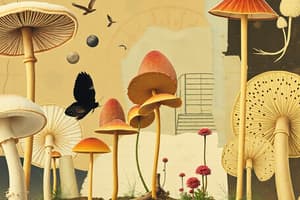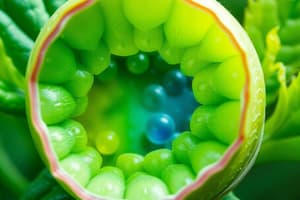Podcast
Questions and Answers
What is the main function of dermal tissue in plant leaves?
What is the main function of dermal tissue in plant leaves?
- Store energy for growth
- Conduct photosynthesis
- Transport nutrients throughout the plant
- Facilitate gas exchange and protect from water loss (correct)
Which of the following best describes phototropism?
Which of the following best describes phototropism?
- Random growth patterns in response to environmental factors
- Directional growth of plants towards sunlight (correct)
- Plants growing away from light sources
- Growth of plants towards gravity
What role does the vascular tissue play in plant stems?
What role does the vascular tissue play in plant stems?
- Provides structural support
- Absorbs water and minerals from soil
- Facilitates photosynthesis
- Transports nutrients and stores energy (correct)
What is gravitropism in plants?
What is gravitropism in plants?
Which of the following statements about ground tissue is true?
Which of the following statements about ground tissue is true?
What is the primary function of the palisade mesophyll in a leaf?
What is the primary function of the palisade mesophyll in a leaf?
Which layer of the leaf is responsible for preventing water loss?
Which layer of the leaf is responsible for preventing water loss?
How do guard cells affect gas exchange in a leaf?
How do guard cells affect gas exchange in a leaf?
Which tissue is primarily involved in transporting sugars throughout the plant?
Which tissue is primarily involved in transporting sugars throughout the plant?
What role do intercellular air spaces play in the leaf structure?
What role do intercellular air spaces play in the leaf structure?
What is the primary function of the shoot system's leaves in plants?
What is the primary function of the shoot system's leaves in plants?
Which level of organization is directly composed of similar cells performing a specific task?
Which level of organization is directly composed of similar cells performing a specific task?
Which organ is part of the circulatory system in plants?
Which organ is part of the circulatory system in plants?
What does the root system primarily help plants to do?
What does the root system primarily help plants to do?
Which option correctly identifies the relationship between organ systems and organisms?
Which option correctly identifies the relationship between organ systems and organisms?
What primary process enables water to be drawn up through the xylem in plants?
What primary process enables water to be drawn up through the xylem in plants?
Which factor does NOT contribute to the movement of water through the xylem?
Which factor does NOT contribute to the movement of water through the xylem?
How far can water be drawn up the xylem vessels to the leaves in some plants?
How far can water be drawn up the xylem vessels to the leaves in some plants?
Which process describes the loss of water through stomata in plants?
Which process describes the loss of water through stomata in plants?
What is the role of cohesion in the movement of water in plants?
What is the role of cohesion in the movement of water in plants?
What defines cohesion in the context of water molecules?
What defines cohesion in the context of water molecules?
Which statement accurately describes root pressure?
Which statement accurately describes root pressure?
What causes water to enter root hairs?
What causes water to enter root hairs?
What role do xylem cell walls play in the movement of water in plants?
What role do xylem cell walls play in the movement of water in plants?
How is root pressure generated in plants?
How is root pressure generated in plants?
What happens to guard cells when they take in potassium ions ($K^+$)?
What happens to guard cells when they take in potassium ions ($K^+$)?
Which process primarily drives gas exchange in plants?
Which process primarily drives gas exchange in plants?
What occurs in guard cells during nighttime?
What occurs in guard cells during nighttime?
What role do guard cells play in gas exchange?
What role do guard cells play in gas exchange?
What happens to guard cells when light strikes them?
What happens to guard cells when light strikes them?
What is the primary function of the cuticle in plant leaves and stems?
What is the primary function of the cuticle in plant leaves and stems?
Which statement accurately describes the composition of ground tissue?
Which statement accurately describes the composition of ground tissue?
What distinguishes xylem from phloem in vascular tissue?
What distinguishes xylem from phloem in vascular tissue?
Which function does ground tissue NOT perform?
Which function does ground tissue NOT perform?
What describes the dermal tissue in herbaceous plants?
What describes the dermal tissue in herbaceous plants?
What is a key reason multicellular organisms develop specialized cells and tissues?
What is a key reason multicellular organisms develop specialized cells and tissues?
Which of the following best illustrates the concept of cell specialization in multicellular organisms?
Which of the following best illustrates the concept of cell specialization in multicellular organisms?
How does specialization enhance the survival and reproduction of multicellular organisms?
How does specialization enhance the survival and reproduction of multicellular organisms?
Which example demonstrates the role of specialization in a multicellular organism?
Which example demonstrates the role of specialization in a multicellular organism?
In what way does specialization in cells improve their functionality?
In what way does specialization in cells improve their functionality?
What is the primary gas that enters a plant leaf through the stomata?
What is the primary gas that enters a plant leaf through the stomata?
What do lenticels primarily function as in plants?
What do lenticels primarily function as in plants?
Which gas is produced during photosynthesis and released into the atmosphere?
Which gas is produced during photosynthesis and released into the atmosphere?
What type of gas exchange occurs primarily through small openings on the stems of plants?
What type of gas exchange occurs primarily through small openings on the stems of plants?
What role do intercellular spaces play during gas exchange in leaves?
What role do intercellular spaces play during gas exchange in leaves?
What distinguishes meristem tissue in plants from other types of tissues?
What distinguishes meristem tissue in plants from other types of tissues?
Which statement accurately describes the function of guard cells?
Which statement accurately describes the function of guard cells?
What is the primary role of xylem in plants?
What is the primary role of xylem in plants?
How do root hairs enhance a plant's ability to absorb resources?
How do root hairs enhance a plant's ability to absorb resources?
Which of the following accurately describes chloroplasts in plant cells?
Which of the following accurately describes chloroplasts in plant cells?
Flashcards
What is phototropism?
What is phototropism?
Directional growth in response to sunlight.
What is gravitropism?
What is gravitropism?
Directional growth in response to gravity.
What is dermal tissue?
What is dermal tissue?
Outer layer of plant tissues, providing protection and gas exchange.
What is ground tissue?
What is ground tissue?
Signup and view all the flashcards
What is vascular tissue?
What is vascular tissue?
Signup and view all the flashcards
What is the cuticle?
What is the cuticle?
Signup and view all the flashcards
What is the upper epidermis?
What is the upper epidermis?
Signup and view all the flashcards
What is the spongy mesophyll?
What is the spongy mesophyll?
Signup and view all the flashcards
What are guard cells?
What are guard cells?
Signup and view all the flashcards
What are stomata?
What are stomata?
Signup and view all the flashcards
What is transpiration?
What is transpiration?
Signup and view all the flashcards
What is transpiration pull?
What is transpiration pull?
Signup and view all the flashcards
What is cohesion?
What is cohesion?
Signup and view all the flashcards
What is adhesion?
What is adhesion?
Signup and view all the flashcards
What is root pressure?
What is root pressure?
Signup and view all the flashcards
What are organelles?
What are organelles?
Signup and view all the flashcards
What are tissues?
What are tissues?
Signup and view all the flashcards
What are organs?
What are organs?
Signup and view all the flashcards
What are organ systems?
What are organ systems?
Signup and view all the flashcards
What is an organism?
What is an organism?
Signup and view all the flashcards
Cohesion
Cohesion
Signup and view all the flashcards
Adhesion
Adhesion
Signup and view all the flashcards
Root pressure
Root pressure
Signup and view all the flashcards
Active transport in roots
Active transport in roots
Signup and view all the flashcards
Osmosis in roots
Osmosis in roots
Signup and view all the flashcards
Gas Exchange in Plants
Gas Exchange in Plants
Signup and view all the flashcards
How do stomata open and close?
How do stomata open and close?
Signup and view all the flashcards
Single-celled organism function
Single-celled organism function
Signup and view all the flashcards
Multicellular organism specialization
Multicellular organism specialization
Signup and view all the flashcards
Benefits of cell specialization
Benefits of cell specialization
Signup and view all the flashcards
Transpiration pull
Transpiration pull
Signup and view all the flashcards
Cohesion of water molecules
Cohesion of water molecules
Signup and view all the flashcards
What is xylem?
What is xylem?
Signup and view all the flashcards
What makes a cell an open system?
What makes a cell an open system?
Signup and view all the flashcards
What is meristem tissue and where is it found?
What is meristem tissue and where is it found?
Signup and view all the flashcards
What is the function of root hairs?
What is the function of root hairs?
Signup and view all the flashcards
How do dermal cells protect plants?
How do dermal cells protect plants?
Signup and view all the flashcards
What are the functions of xylem and phloem?
What are the functions of xylem and phloem?
Signup and view all the flashcards
Stomata
Stomata
Signup and view all the flashcards
Lenticels
Lenticels
Signup and view all the flashcards
Carbon dioxide diffusion in leaves
Carbon dioxide diffusion in leaves
Signup and view all the flashcards
Photosynthesis
Photosynthesis
Signup and view all the flashcards
Study Notes
Phototropism
- Phototropism is the directional plant growth in response to sunlight
- Plants grow towards sunlight
Gravitropism
- Gravitropism is the directional plant growth in response to gravity
- Plants know which way is up
Function of Tissues
| Organ | Dermal (epidermal) | Ground | Vascular |
|---|---|---|---|
| Leaf | Gas exchange Protection from water loss and disease |
Photosynthesis Support Storage |
Transport Storage |
| Stem | Gas exchange Protection from water loss and disease Absorption of water and minerals from soil |
Support Storage |
Transport Storage |
Studying That Suits You
Use AI to generate personalized quizzes and flashcards to suit your learning preferences.
Description
This quiz explores the functions of various plant tissues including dermal, vascular, and ground tissues. Questions cover topics such as phototropism, gravitropism, and the roles of different leaf structures in plant physiology. Test your knowledge on how these tissues contribute to the overall function of plants.




